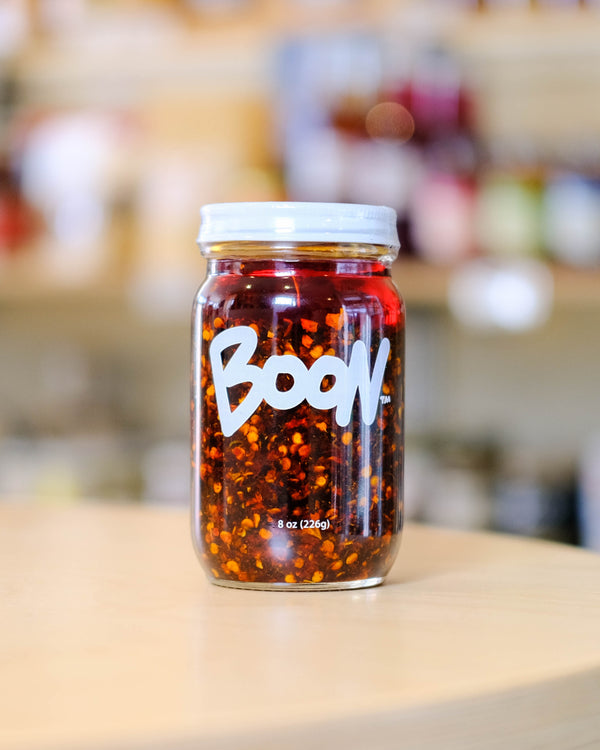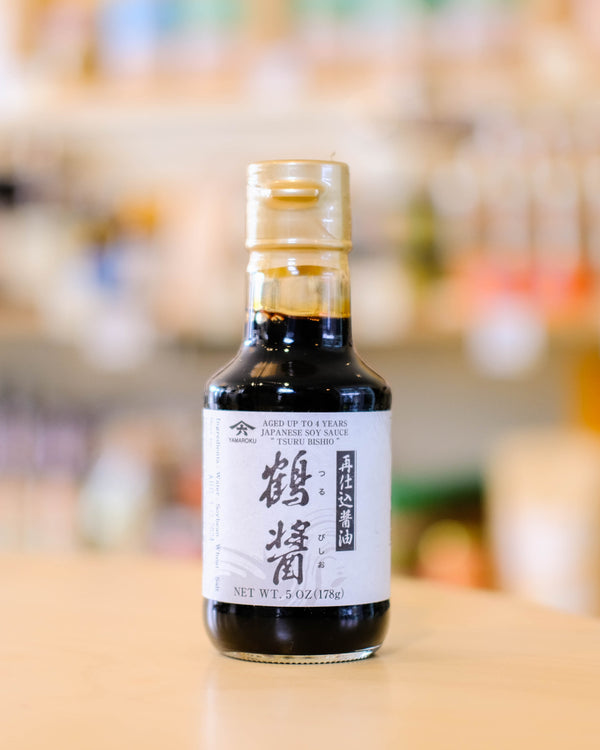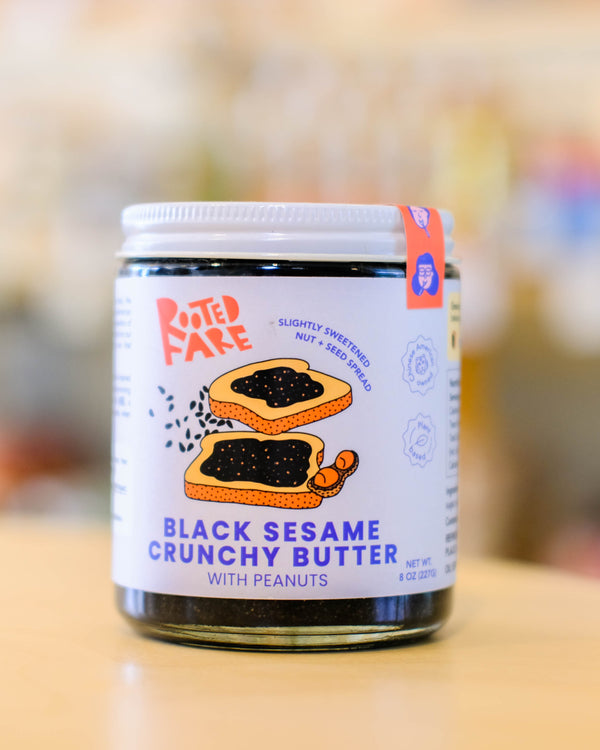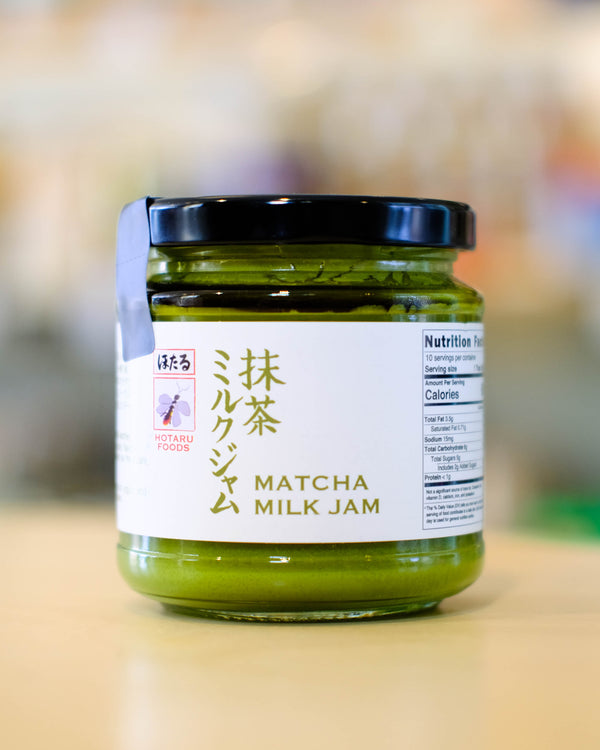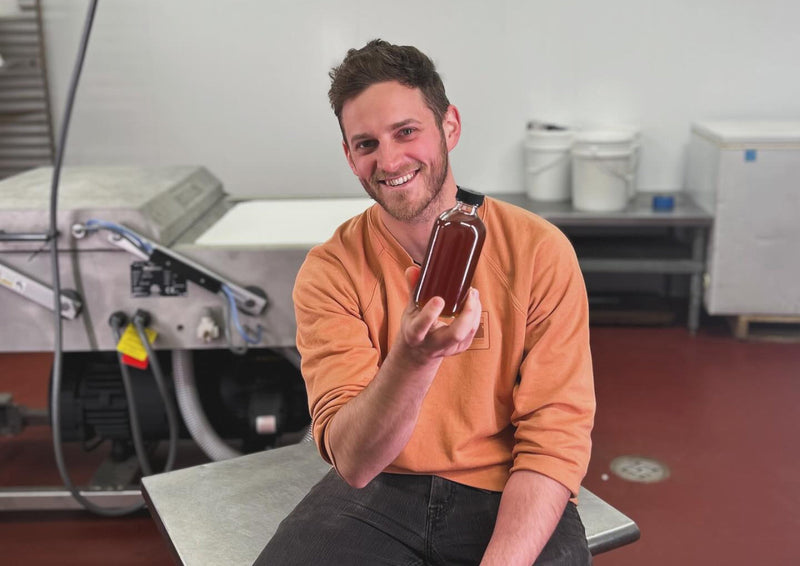Photo: Jars of umeboshi and other ferments at Kamoshika Kyoto fermentation cafe, Arashiyama, Kyoto
In our highly connected world, there’s a strong chance that most of us have eaten traditional fermented foods from Japan. I mean, who doesn’t know (and love) miso, sake, and soy sauce?
Large amounts of Japanese fermented foods are used everyday as condiments like mirin, bonito flakes (katsubushi), and rice vinegar to well known classics like sake, shochu, and even pickled plums (umeboshi).
Ferments hailing from Japan have made their way into food cultures worldwide and have earned reputations of high praise from some of society’s most reputable chefs and average homecooks alike. With Japanese food, known as washoku, gaining popularity and recognition on the world scale due to its irresistible levels of umami, numerous health benefits, and millennia long traditions of production, brews such as sake, miso, and soy sauce have become ubiquitous in most people’s pantries; our customers are a prime example!
The world of fermented foods in Japan, called hakko shokuin, dates back thousands of years and dives a lot deeper than what has become internationally popular today. Influences from food regions such as China, Korea, India, and beyond have inspired Japanese food artisans over centuries to preserve their unique fermentation heritage and expand it into uncharted territories.
In April, I was fortunate enough to spend two months based in Kyoto. Attempting to live the life of an average Kyoto-ite, I am sure I ate more fermented food than I was even aware of.
Some of what found its way onto my plate was familiar while other dishes were an entirely new experience. I couldn’t help but take a closer look at five fermented foods you may not have heard of or wish you knew more about during my time in one of my favorite cities in the world:

Photo: Homemade natto on top of rice and salad at Kamoshika Kyoto fermentation cafe, Arashiyama, Kyoto.
Natto
Natto, a gooey mix of fermented soybeans, has become increasingly well known worldwide over the last few years. Most who have tried its nutty and astringent flavor will tell you that they either hate it, or absolutely love it!
Natto is becoming increasingly popular internationally after recently being identified as a food with one of the highest naturally occurring sources of Vitamin K12 (a vitamin exceedingly believed to prevent cancers). However, in Japan, natto is an age-old staple gracing tables for over 1,000 years. Available anywhere from your local izakaya and neighborhood Seven Eleven to the vessel stewing on your auntie’s countertop, one will never find themselves too far from a serving of natto in the Land of the Rising Sun.
Personally, I fall under the category of a diehard natto lover. Natto has become an everyday staple in my diet, with NYrture’s black natto taking up sustained residence in my fridge back home in Maine.
In Japan, I was spoiled to try numerous homemade batches of natto at friends’ houses in Nagano and at the popular fermentation cafe, Kamoshika Kyoto, in Arashiyama. Between each batch, I was struck by how different regions, soy varieties, and environments produce different styles and flavors of natto across Japan.
My friend’s homemade natto, nestled deep in Nagano’s Central Alps in the small, secluded town of Ogawa, reflected the terroir of the cold, mountainous region from which it was born. My friend explained to me that she had fermented the beans with koji inoculated rice, wakame seaweed, and small shredded pieces of carrot. It was the first time I had tried natto fermented with multiple ingredients instead of only soybean. The result was a sweet, umami-forward mixture, with a drier texture, similar to that of baked beans.
Kamoshika Kyoto’s natto resembled a style I was more familiar with: gooey, pungent, and earthy. Their housemade natto had a bright, citrus component that pleasantly complemented the mix of vinegar-coated greens and rice it rested on top of. I loved that in Kamoshika Kyoto’s ferment oriented cafe, I could order a natto lunch set, making what is so often seen as a side dish the main event of the meal.
If you’re curious about trying natto yourself, you can reach into Onggi’s market fridge and grab yourself a jar of the gooey beans made by NYrture, a Brooklyn based New York natto business using organic soybeans to make a slimy side dish with love.
Kouso
Maybe you’re familiar with umeshu, a lacto-fermented plum juice, but have you heard of kouso? Originating fairly recently in 1949, kouso is a fermented syrup, traditionally made with (sometimes up to twenty) different fruits, vegetables, and herbs.
During my time in Kyoto, I didn’t even realize I was drinking kouso regularly until I arrived back in the States. Weeks of traveling on airplanes, bullet trains, subways, and a thirteen hour time difference can cause illness to catch up with a girl. Anytime I felt a cold coming on, I stopped by my neighborhood supermarket in Kyoto’s Sakyo Ward and drank kouso from a pouch like a mini Vitamin C shot.
I never once got sick! And, let’s face it, kouso was so refreshing that I found an opportunity to drink the bubbly, tangy ferment like juice any chance I got.
I later learned that kouso is a well-known secret in Japan for maintaining everyday beauty and health. As it turned out, my natural inclination to reach for it almost daily was quite similar to how locals preferred it.
Next time you’re feeling a little under the weather, or you simply want to elevate any homemade mocktail, I highly recommend you give kouso a try. You can find local Maine maker Goen's Elderberry Kouso in Onggi’s market.
Nukazuke
Before the days of high speed trains and cars, Kyoto’s landlocked topography surrounded by mountains slowed the influx of food from other parts of the country, specifically Japan’s coastal regions. As a result, heirloom vegetable varieties specific to Kyoto’s regional climate, known as kyoyasai, have been farmed in the region for centuries. And as my favorite saying goes, where there is a strong vegetable culture, there will be pickles.
Part of a wide variety of pickled vegetables, known as tsukemono, nukazuke are pickled vegetables fermented in roasted rice bran, salt, and kombu.
I kept my apartment’s fridge stocked with nukazuke eggplants, cucumber, and daikon radish at all times from Nishiki and Ohara markets. At first, I was intimidated by the concept of using and cooking with them. However,, after giving the veggies a quick rinse under water, they made delicious additions to simple bowls of rice, salads, or makeshift sandwiches when I was working late and didn’t have the time or energy to cook in my studio apartment’s postage-stamp-sized kitchen.
I found nukazuke vegetables to be salty, savory, and subtly sour with a crunchy texture I couldn’t get enough of. I became so hooked on these pickles that I even brought a package of the rice bran starter home to America from Kamoshika Kyoto to try my hand at nukazuke from home!
Unfortunately, TSA decided to thwart my nukazuke fermenting endeavors before they could even begin, and I was decently disheartened to find the bag of nukazuke in my luggage confiscated from my suitcase when I returned to Maine. I hope wherever they are, that TSA agent is enjoying some crispy, umami veggies in my stead.
Yuzu Kosho
Different from kouso, kosho is a delicious paste made of fermented chili peppers and salt that adds a bright, semi-spicy tang to your dish. Yuzu kosho involves the addition of fermented yuzu citrus peel, and is often used as a condiment on yakiniku grilled meats, a dipping sauce for gyoza, sushi, or stirred into soups.
My favorite taste of yuzu kosho came from the generational pantry of one of Nishiki Market’s oldest spice vendors, Jintora, who has been in production since 1878. The obaachan working behind the counter ensured I was not without copious amounts of samples before buying their Kyushu-grown and processed yellow yuzu kosho, the spiciest of their offerings.
Jintora’s yuzu kosho carried sour notes of citrus married perfectly with mellow earthiness, with a higher spice level than I had tasted from brands in America. To this day, I can’t eat the stuff without thinking of the warm hospitality Jintora’s artisans showed me during my first trip to Japan, overwhelmed, low on language skills, and stumbling through the crowded market.
Luckily, I was blessed enough to have yuzu kosho available as soon as I arrived home. Now, after spending my Saturdays in Onggi’s market, I always take home a pouch of Yuzuco’s Yuzu Kosho to restock my pantry.
Shio Koji
Recently, the most well known agent (but certainly not the only) that has made many Japanese ferments notorious for their trademark umami flavor is a type of mold known as koji, with some even touting it as the ‘next big thing in global food trends since salt.’
A condiment most commonly used for marinating meats, as a dip for yakiniku, or as a topping on vegetables, rice, and other meals, shio koji is a quick and easy ferment widely made in households across Japan.
I make my own shio koji, both while at home and abroad, and have had a lot of fun exploring its versatile nature. Whether it be making shoyu koji (shio koji made with soy sauce instead of water), or adding flavorful additions like chopped onions to my latest batch, it’s a rare event that the savory mixture isn’t flavoring some aspect of my meal.
On a random Saturday evening a friend of mine and I found ourselves stumbling into an unsuspecting machiya that housed a dimly lit, Japanese barbecue restaurant. With smoke from both charcoal grills and customers’ cigarettes wafting up to the hundred-year-old beams, I experienced shio koji in arguably its best form.
I am convinced I will never stop dreaming of yakiniku (generally), but especially not the flavor combination of dipping Hokkaido raised wagyu in fresh shio koji with bits of char from the grill boosting the bite’s rich, fatty flavor.
While I can’t promise you can find wagyu beef as fresh or delicious in your local grocery store, you can purchase Goen’s inoculated rice in Onggi’s market to try your own hand at making shio koji, and maybe other experiments along the way!
Beyond the Traditional
Japan’s culture of fermentation dives much deeper (and a lot farther back in time) than the short list featured above, including fermented teas, fish sauces, and specific dishes such as oyaki and menma whose history, flavor, and methodology differs depending on the region.
As demand for Japanese food continues to grow internationally, Japanese producers, chefs, artisans, and home cooks are pushing the envelope on modern hakko shokuin. While popularity and demand for Japanese food grows abroad, foreign ferments have become more common domestically in Japan, paving the way for new makers to place their mark on foods like wine, beer, cheese, and sourdough breads.
Microbreweries such as Nobara in Nagano and winemakers like Kyoeido in Yamanashi are utilizing Japanese ingredients and local terroir to refine and expand the definition of hakko shokuin in the palates of consumers everywhere.
I left Japan with my mind and tastebuds expanded and list of both sampled and untried eats, makers, restaurants, and friends fresh on my itinerary. I always leave with the sense that I could spend a lifetime exploring its towns and foods. To the new friends I made, the makers who shared their craft with me, and those who opened up their pantries, homes, and hearts, I am beyond grateful - and I can’t wait to try what you make next.

